Slow Cook Beef Bone Broth Instapot


A few years ago, when I heard the term "bone broth" getting thrown around for the first time, my initial thought wasum, isn't chicken broth already made with bones?It wasn't until about a year ago that I found out that bone broth is different from regular chicken stock because it uses a long cooking time to extract as much nutrition out of the bones as possible and tends to use bones that have more connective tissue—like necks, feet, and knuckles. Basically, regular stock uses the bones for flavor. Bone broth uses the bones for flavor and nutrition.
The resulting bone broth from long-simmering is totally delicious, of course, but even beyond that, it's a powerful nutritional supplement. In fact, I only started making bone broth regularly after two separate doctors (one crunchy granola doc and one decidedly not crunchy granola doc) recommended I start having at least a cup of it a day as part of my Lyme treatment protocol. Bone broth walks the line between food and medicine in a way that few other foods do. And it certainly tastes a lot better than most medicines do!
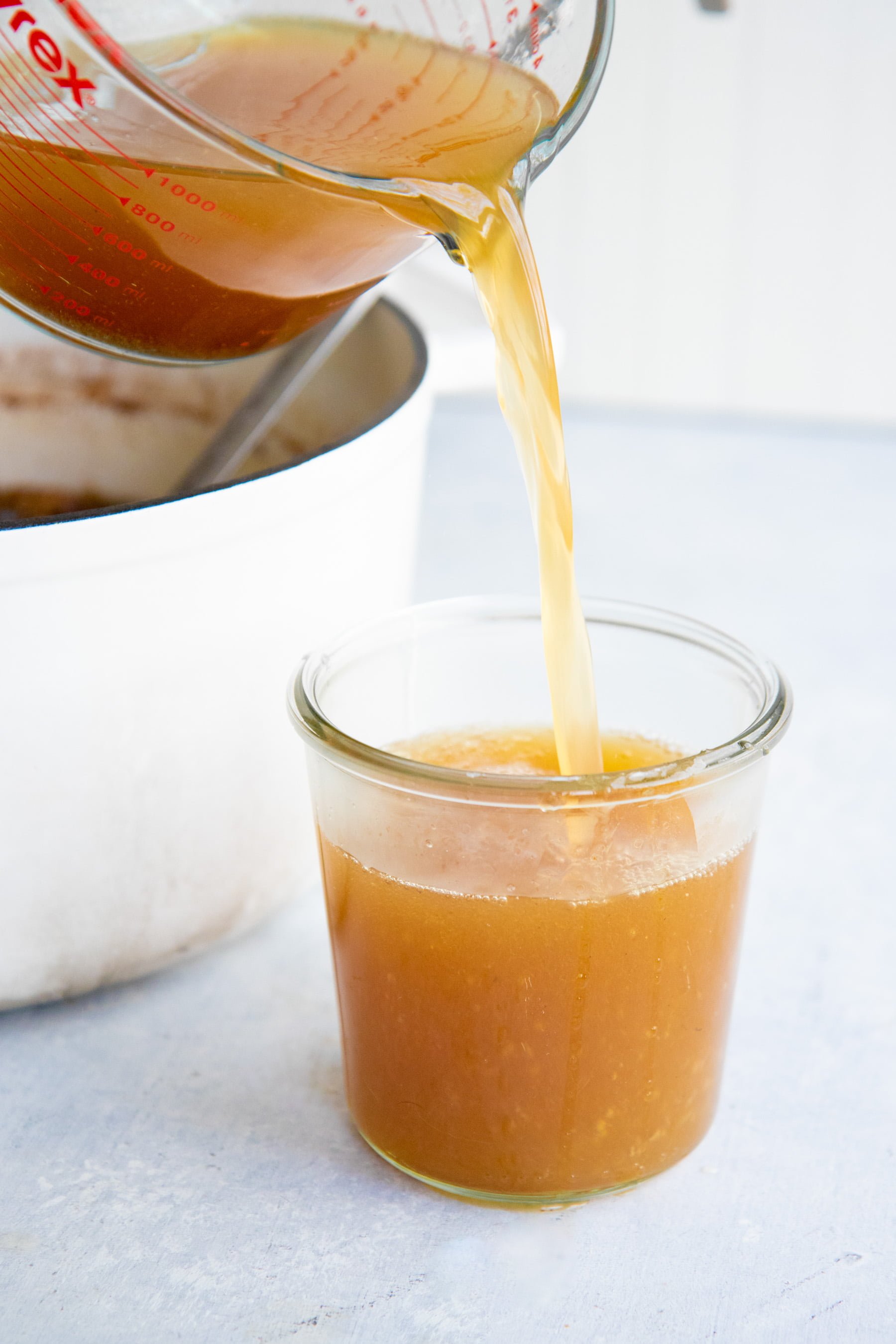
What are the benefits of bone broth?
The nutritional profile of bone broth depends widely on the kind of bones you use (you can use chicken, turkey, beef, pork, fish—anything!), your cooking time, and the way the animals were raised (grass-fed and pasture-raised animals will give you more nutrient density). But there are a few common things about bone broth that make it so awesome:
- It's loaded with gelatin. The slow and low cooking helps to release the gelatin—which is a broken-down version of collagen—that is in the connective tissues and bones you use. Why is this a good thing? Well, major important areas of our body (like the lining of our gut and our own connective tissues and joints) are made from collagen—in fact, about 25% of our body is made of collagen! Some folks use gelatin or collagen supplements, but bone broth is another effective (and affordable) way to get your gelatin and collagen. Making sure you get an adequate supply of collagen has a ton of health benefits like helping you sleep better, making your skin more supple, protecting your gut lining, and making your joints less achy.
- It's easy to digest. Sometimes the roughage of a huge salad is good for you, but sometimes—especially if you are fighting digestive disorders or your immune system isn't up to snuff—easy-to-digest foods are the way to go. Bone broth is a wonderful marriage of easy-on-the-digestion-system, but still nutritionally powerful.
Is bone broth some new fancy food trend?
While bone broth is quite trendy now, it is absolutely not a new food! Healing broths and stocks have been part of the vast majority of cultures for centuries. Chances are if you can speak with an elder in your community, they can tell you stories about healing bone broth and soups from their childhood. If you'd like to read more about traditional foods and how they are (unfortunately) missing from our current diets, I highly recommend checking out Nourishing Traditions by Sally Fallon. It's an incredibly eye-opening look into how we've stripped away the traditional preparation methods for many of our foods in the interest of saving-time.
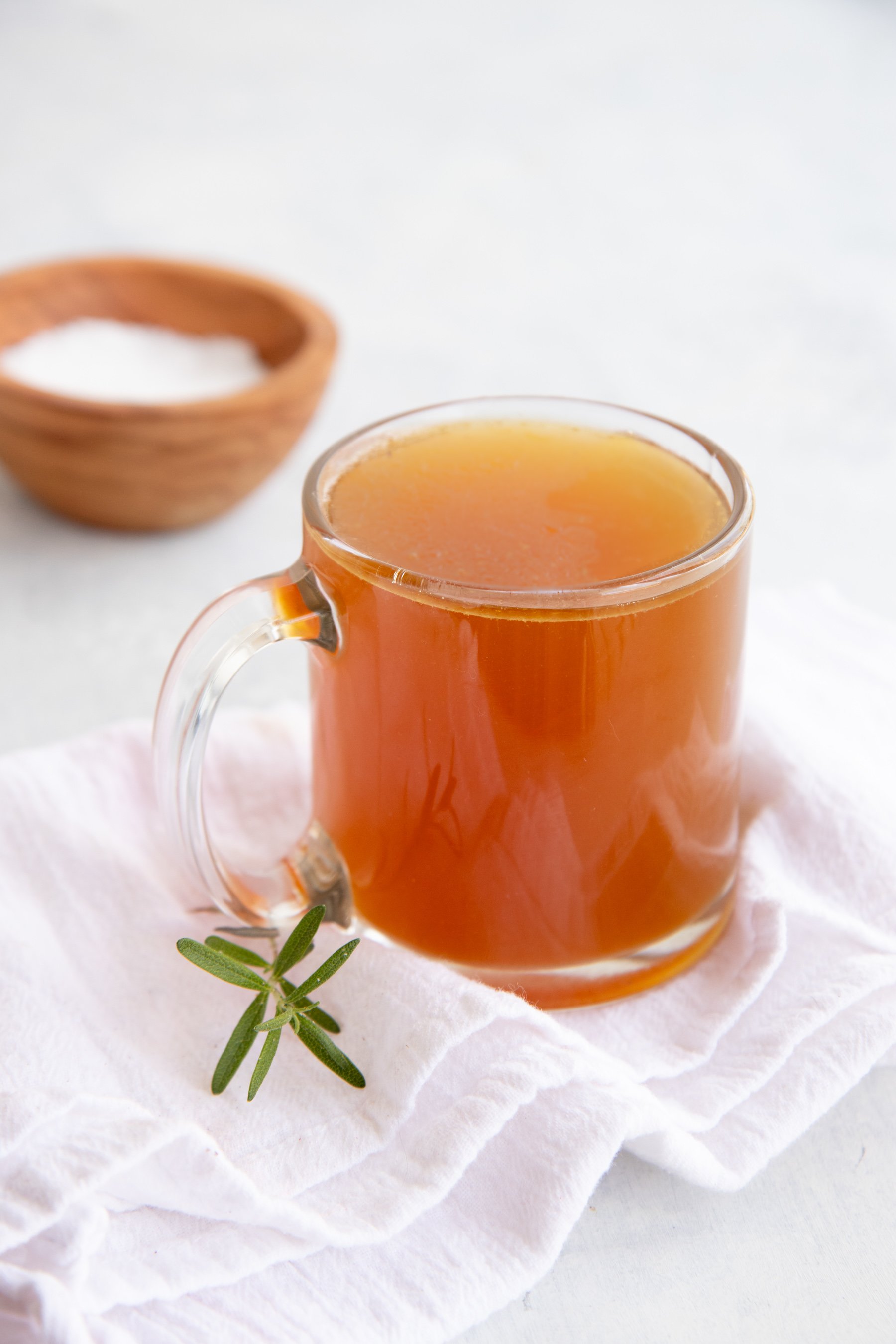
How to do you make bone broth?
While bone broth can be incredibly time-consuming to make (three hours at it's fastest in your Instant Pot or up to two days using other methods), it is also incredibly simple. To make it, all you have to do is:
- Cook or roast animal bones.
- Soak shortly in filtered water and apple cider vinegar.
- Add any seasonings or flavorings you prefer.
- Cook over very low heat until done. That's it!
And while the vast majority of the cooking time is hands-off (we're talking like 99% of the time), I do like to keep a few cartons of shelf-stable bone broth in my pantry for when I'm running short on time. I usually purchase Kettle & Fire Bone Broth because I've found the quality incredibly high!
How do you use bone broth?
You can use bone broth just like you would any other stock or broth. Use it to make chicken zoodle soup. Use it to cook quinoa or barley. Use it to make the best ever mashed potatoes. Use beef bone broth in beef stew. Many fans also prefer to drink it straight—as a sipping broth. The long-simmering of the broth gives it a complex, rich flavor that is cozy, comforting, and warm. I personally love having bone broth as a nightcap! The gelatin in the broth helps promote a restful night's sleep, which makes it the perfect before bed drink. A cold winter night by the fireplace with my puppies snuggled at my feet and a mug of bone broth in my hands is pure bliss for me!
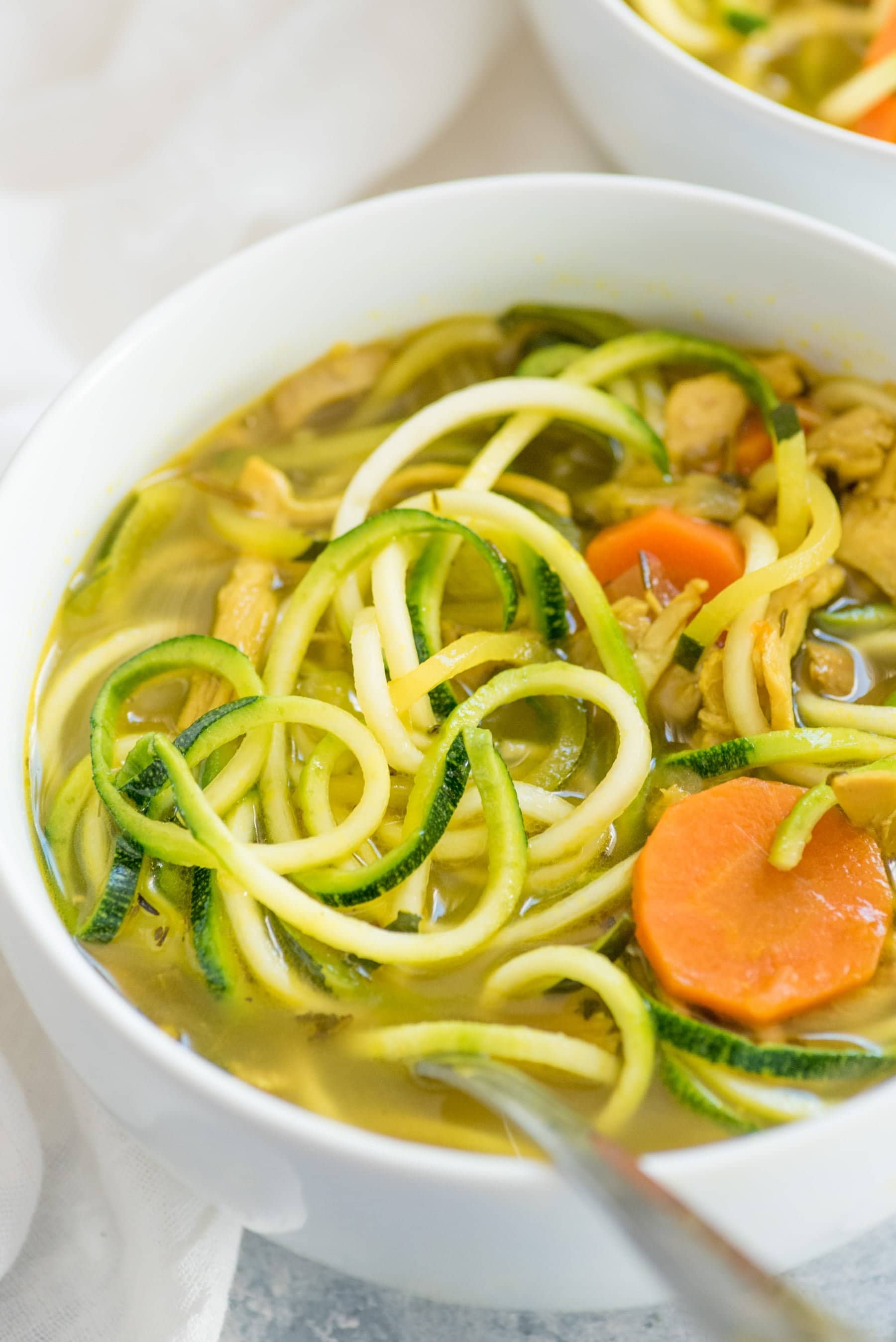
What are the best bones for bone broth?
I believe the best bones for bone broth are the ones you have! I always make it after roasting a chicken—because those are the bones I have on hand. Waste not, want not! For the absolute highest collagen content in your broth (meaning it will gel the best), you're looking for bones that are full of connective tissue. You want to use necks, feet, backs, joints, and knuckles where possible. I tend to keep some of these on hand in my freezer to add into a batch of bone broth whenever I want to boost the nutrition. Yes, I have a bag of chicken feet in my freezer! Protip: they also make great dog treats.
Where do I get bones for bone broth?
The idea of tracking down some chicken feet to make bone broth seem impossible? It's actually not! Hit up your local farmer's market and talk to some of your meat vendors. Because most folks want to buy steaks and chicken breasts, a lot of the less desirable animal parts that are perfect for bone broth can be purchased for a screaming steal from a local farmer. We purchase chicken feet for $4 for a five-pound bag from a local organic/pasture-raised farm near us—and that lasts us for almost a full year of weekly broth making! If finding a local farmer isn't an option, you might want to find a full-service butcher near you. They have the same issue as the farmer—lots of animal pieces they won't be putting in their service counter.
If all else fails, many health food stores and food co-ops now sell soup and broth bones in their freezer section. I will warn you that I've found the markup on these bones to be astronomical—we're talking 500% higher than what you can get directly from the source. If you plan on making and enjoying bone broth regularly (you should), it's worth doing the leg work and connecting with a local farmer or butcher once or twice a year to stock up your deep freezer and save some serious cash (probably enough to buy a deep freezer if you don't already have one).
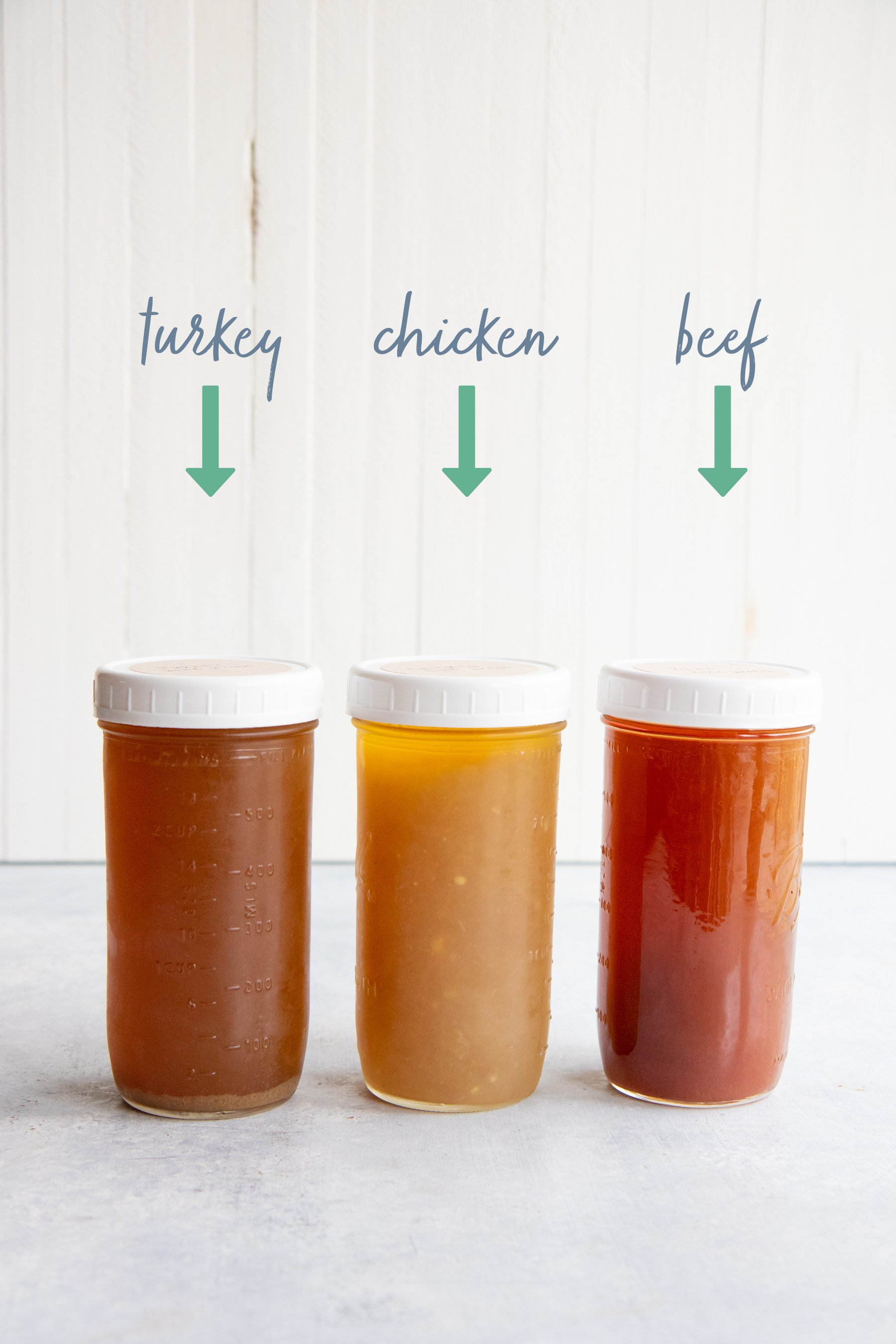
If you get into regularly making bone broth, you can also tweak your meat purchasing to keep in mind your need for broth bones. Instead of buying chicken breasts and chicken legs separately, buy a whole chicken and learn how to cut it up (the chicken back and neck makes GREAT bone broth). Buy bone-in steaks instead of boneless ones. Buy roasts with bones inside. Bonus: because most people consider having a cut of meat that is boneless to be a convenience and advantage, those cuts of meat are usually marked up. You'll be saving money and getting more bang for your buck by purchasing bone-in options!
Is there such a thing as vegetarian or vegan bone broth?
Sorry, Charlie. Y'all know I love making vegan and vegetarian versions of our favorite carnivore dishes (like my Cashew Stuffed Shells or my Vegan Pumpkin Chili), but this is one case where there just isn't a substitute for my herbivore friends. That's not to say you can't make a very good, very healing, very nutritious vegetarian broth—you absolutely can, it's just obviously not going to be "bone" broth! In fact, while plants themselves don't produce collagen, many of them do promote collagen-building within our own bodies—basically, you can make a broth that can help your body repair its own collagen and keep it vegan. Here is a good vegan "bone" broth recipe to try out from MindBodyGreen.
How much bone broth should you drink daily?
As much as you want, honestly. I'd start at one or two cups a day, and see how that makes you feel. When I'm in the depths of a Lyme Disease flare-up, I switch to consuming almost entirely bone broth. I tend to lose my appetite, and bone broth nourishes me enough to give me energy without taxing my body to digest foods it really doesn't want to eat anyway (your body knows best). Since bone broth is a food-based medicine, it's really hard to O.D. on the stuff—enjoy regularly!
Can you freeze bone broth?
I have a basement freezer that is stocked full of bone broth! It's my favorite way to store it. I prefer to avoid plastic when it comes to my food, so I use wide mouth pint-and-a-half Mason glass jars to freeze my broth. These are the largest Mason jars that are freezer-friendly, and the three-cup measure works really well for all my cooking and sipping needs.
Unfortunately, the pint-and-a-halfs can be hard to track down sometimes, so wide mouth pints are a good alternative. Just fill to the freezer line on the jar, put on a cap, label, and stash it in the freezer until needed. I just pull it out and defrost it overnight in the fridge.
If you don't have room in your freezer (or you happen to run out, which happens to me occasionally!), there are a few shelf-stable bone broth brands you can buy at your local grocery store. I personally like the quality and taste of Kettle & Fire Bone Broth , but there are multiple other brands you can test out to find our favorite.
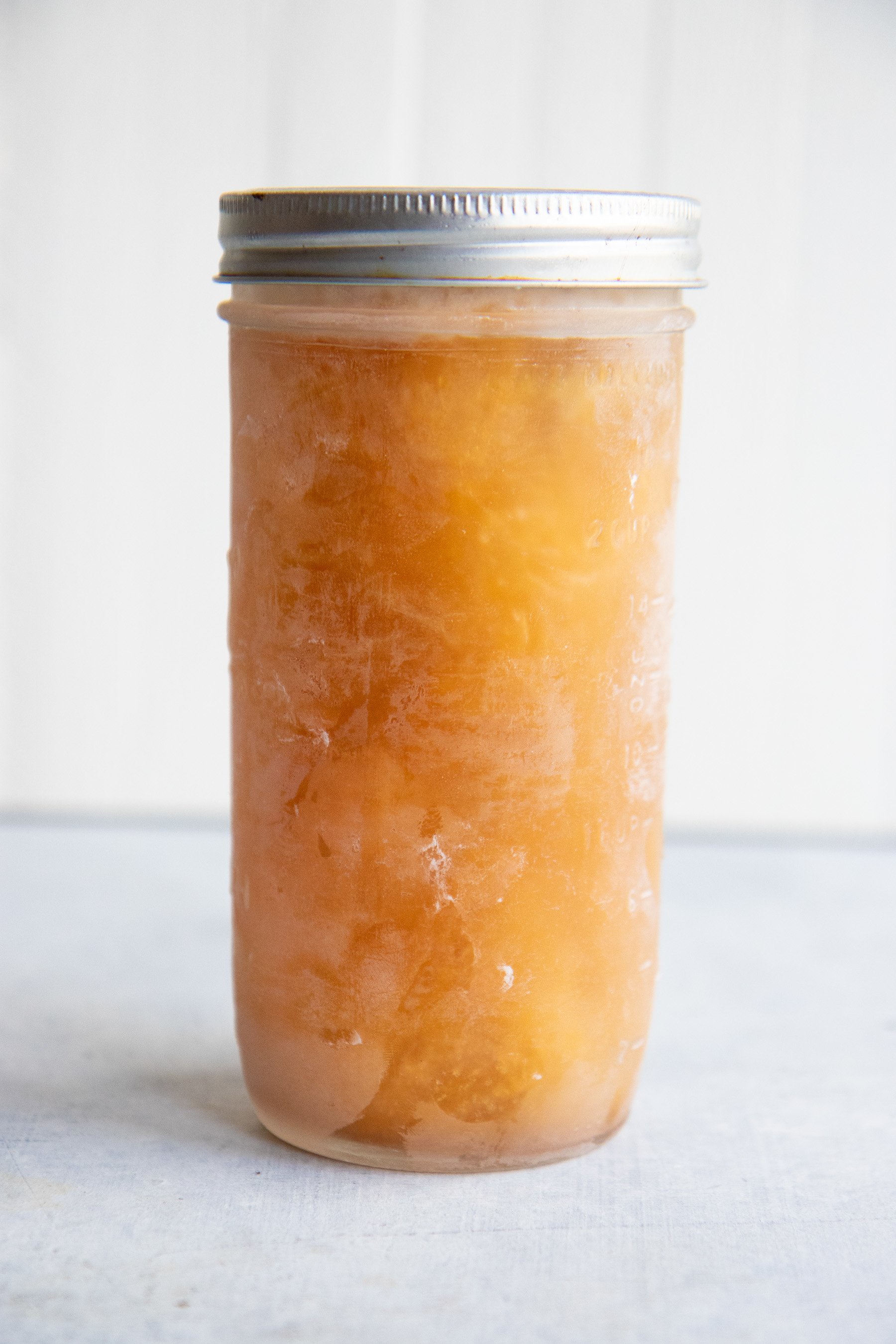
How to Make Bone Broth
You can buy bone broth now at most larger supermarkets, but the convenience comes at a hefty price—about $6 a quart. Good thing it's easy and super affordable to make bone broth at home! If you've ever made chicken stock before, the process is almost exactly the same, the main difference being you just simmer your broth a lot longer. You can use bones from any animal, but the most common are chicken or beef.
Step 1: Blanch and then Roast or Cook the Bones
The key to getting the best flavor from any bones from any animal is to make sure they are roasted or cooked first. If you prefer, you can also blanch your bones to remove impurities that can make the taste go off by submerging them in boiling water for 10-15 minutes and then roasting. I've done the blanching step a handful of times, and I've noticed with chicken, the difference is negligible, and not worth the extra time. With beef bones, however, I always blanch my bones before roasting—it really does result in a tastier broth. I've also noticed the better quality the bones (organic, free-range/pastured, grass-fed, local), the less important the blanching step is, but that's just my personal experience. I highly recommend trying it out both ways (blanched and not-blanched) to see what works best for you.
Either way, you then want to roast your bones. If you are using bones leftover from cooking a whole chicken or making a roast, you can skip this step, since the bones were technically already "roasted" during your initial cooking process, but for any raw or blanched bones, I highly recommend a trip in the oven to get better flavor. I roast bones at 425°F for 25-30 minutes, or until quite browned—it's really hard to over-roast bone broth bones.
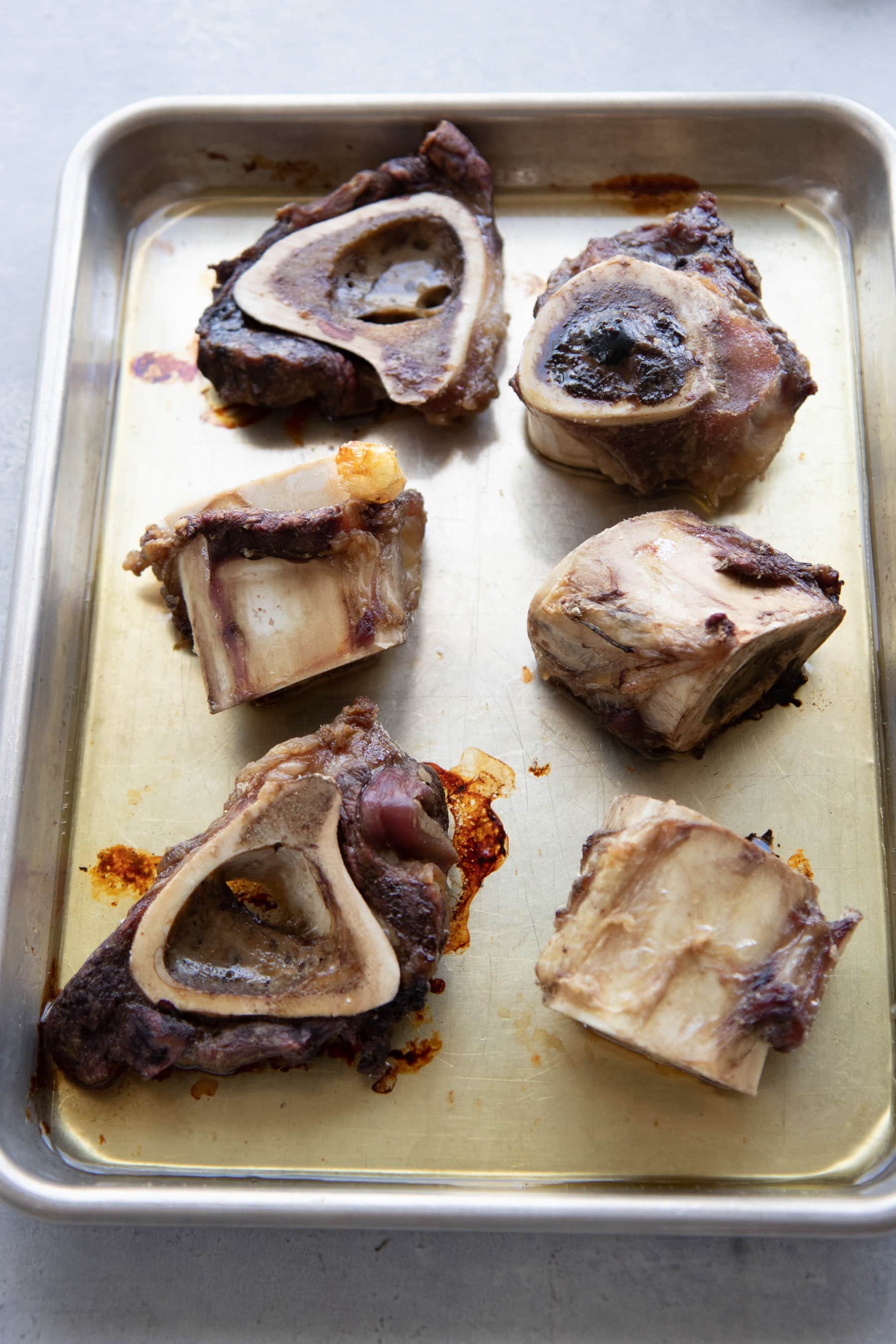
Step 2: Add aromatics, apple cider vinegar, and water. Soak.
In our house, we use the "lazy girl" method of doing broth by saving up veggie scraps in the freezer for later use. I have a freezer bag that all my onion, celery, and carrot scraps go into, and when it's time to make bone broth, I grab a big handful and put in the pot (or Instant Pot or slow cooker) with the roasted bones. You can also roughly chop up fresh aromatics—or use none at all. Some purists would say all you need to make bone broth is bones and water, but I like the complexity a little bit of vegetables add.
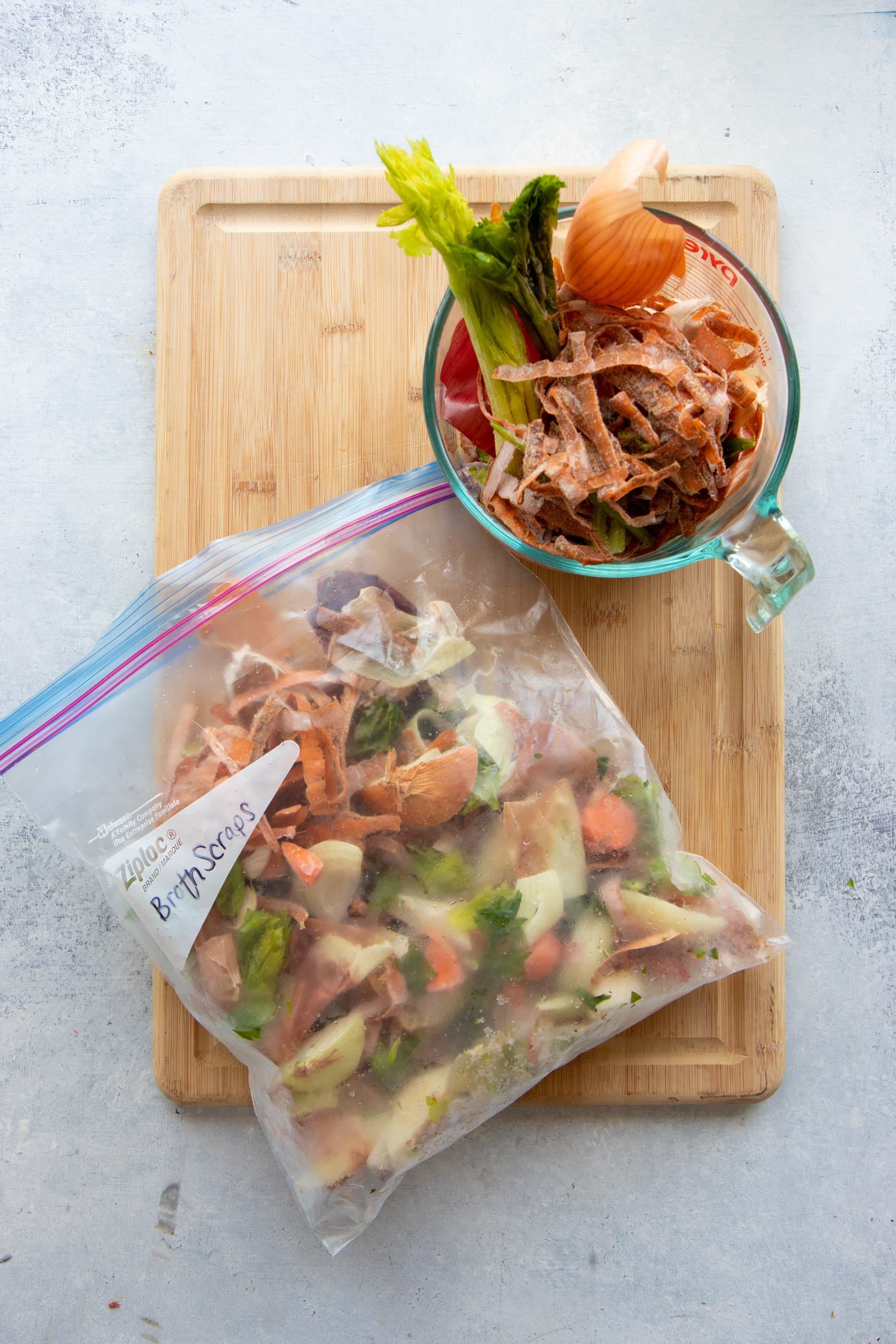
I also add in apple cider vinegar (this helps to more quickly break down the bones so they can release nutrition), bay leaves, whole black peppercorns, and salt. I used to add garlic, but I've found it just becomes too overpowering for my tastes during a long simmer–so I tend to leave it out now. This is just my preference for seasonings–you really can experiment to figure out what your favorite combination is!
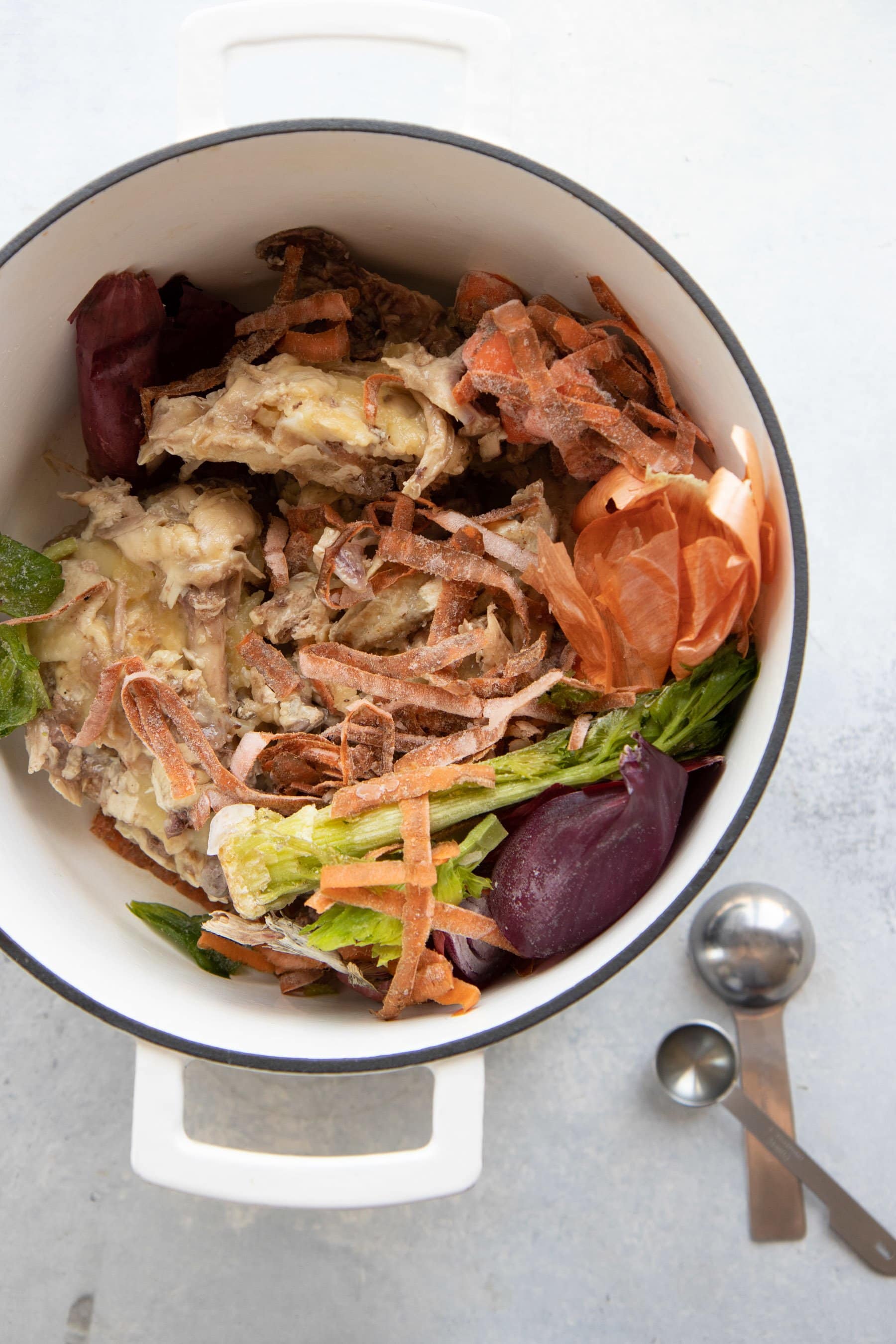
I then cover the bones and scraps with filtered water from my Berkey water filter. I then let the whole mixture soak for about 30 minutes. I've never seen the exact research onwhythis is a common practice when making bone broth—so it might be completely unnecessary—but I figure it doesn't hurt.
Step 3: Cook the broth.
I usually make my bone broth either in the Instant Pot (instructions below) or on the stovetop if my Instant Pot is otherwise occupied (stovetop instructions also below). You can also do it in your slow cooker (and yes, those instructions are also below). After three hours in the Instant Pot or about 24-48 hours on the stovetop, I have bone broth! You want to keep the broth at a simmer (not a boil) at a very low temperature if you're working with the stovetop—I use my smallest burner at the lowest setting. And if you're nervous about letting the broth go on the burner overnight (I get it!), you can definitely take the broth off, store it in the fridge, and then restart the time again in the morning.
Step 4: Strain and store.
I strain the bone broth using a fine-mesh sieve and then pour the liquid into jars for freezing. A layer of fat will solidify at the top of the broth after chilling—you can scoop that off and use it like any other cooking oil. I like to use it to sauté onions! Or you can mix it back into the broth.
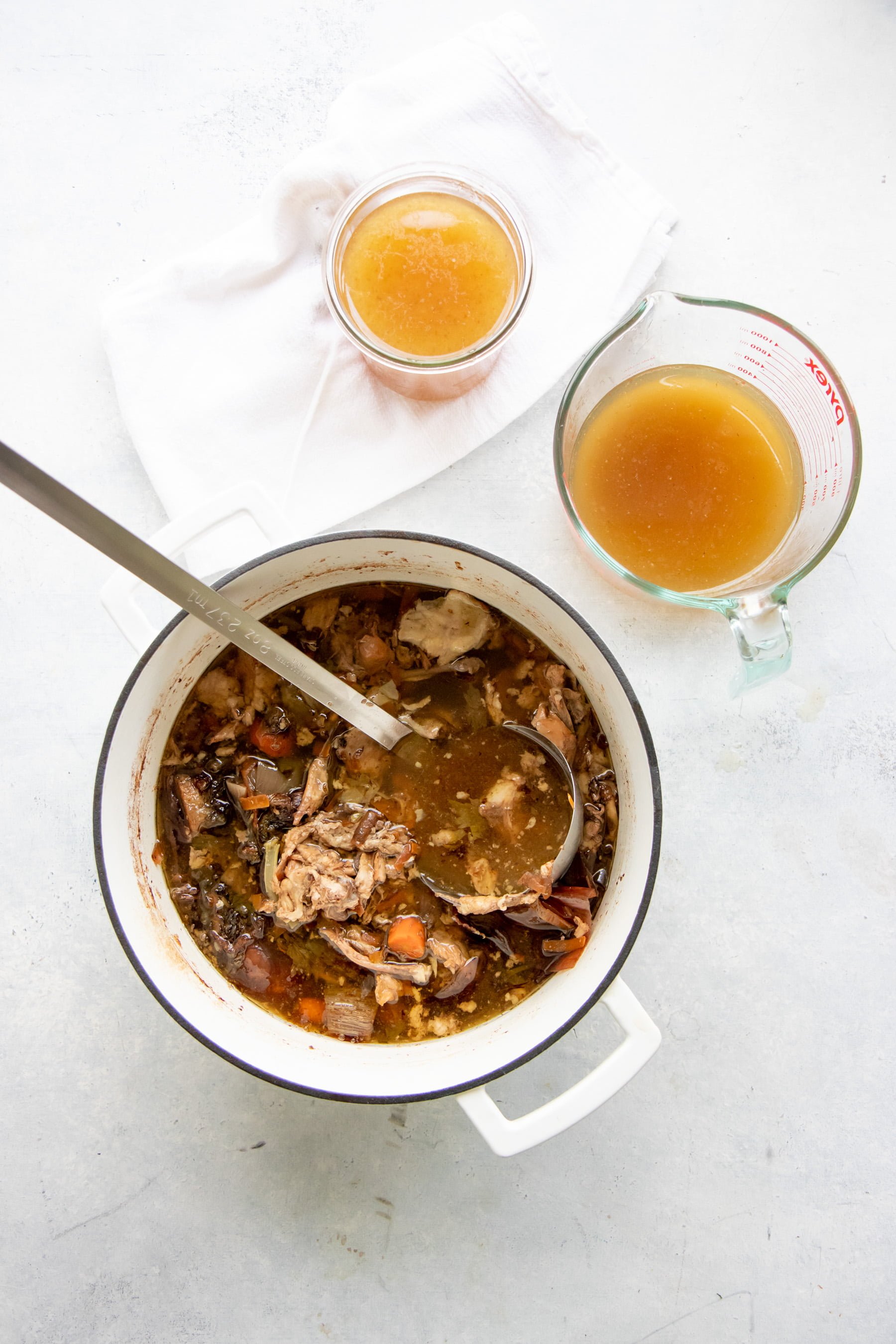
Uh oh! Let's troubleshoot your bone broth.
Once you've nailed down your perfect pot of bone broth, you'll always have that at your disposal, but there might be some trial-and-error along the way. Let me cover some of the questions I had when I first started bone broth-ing.
- My bone broth looks all cloudy/milky! What's wrong?When bone broth is boiled at too high of a temperature for too long, it can get a milky/cloudy appearance to it. I have this happen whenever I use my slow cooker, because it runs a bit too hot. There is nothing wrong with the broth—it's fine to use—it just doesn't look great. Next time, just lower the temperature a little bit.
- My broth is cooking and there is a lot of foam coming up! What do I do? Foam on the top of cooking broth is just impurities in the bones coming out. Just take a slotted spoon and scoop it off. I've noticed that I see almost no foam when I use bones from pasture-raised/grass-fed animals.
- My broth tastes….kinda funky. Did you remember to roast, cook, or blanch your bones before adding it to the broth pot? That tends to be the number one reason why broth gets a funky flavor. Also, makes sure you get the best quality bones from animals that lived a good life.
- My bone broth didn't gel! Whomp. Whomp. Nothing like all that work to get a broth that doesn't gel. But don't worry! The broth is still packed with all kinds of nutrition—even if it isn't super high in gelatin. To make sure your bone broth gels every time, make sure to include bones that have connective tissues. Feet, knuckles, necks, backs, joints, etc. You'll be amazed at how affordably you can buy these usually unwanted bones from your local butcher or farm. We keep a bag of chicken feet in our freezer for just this purpose (and for dog treats!). I throw one or two chicken feet into each batch of broth, and it gels perfectly every time.
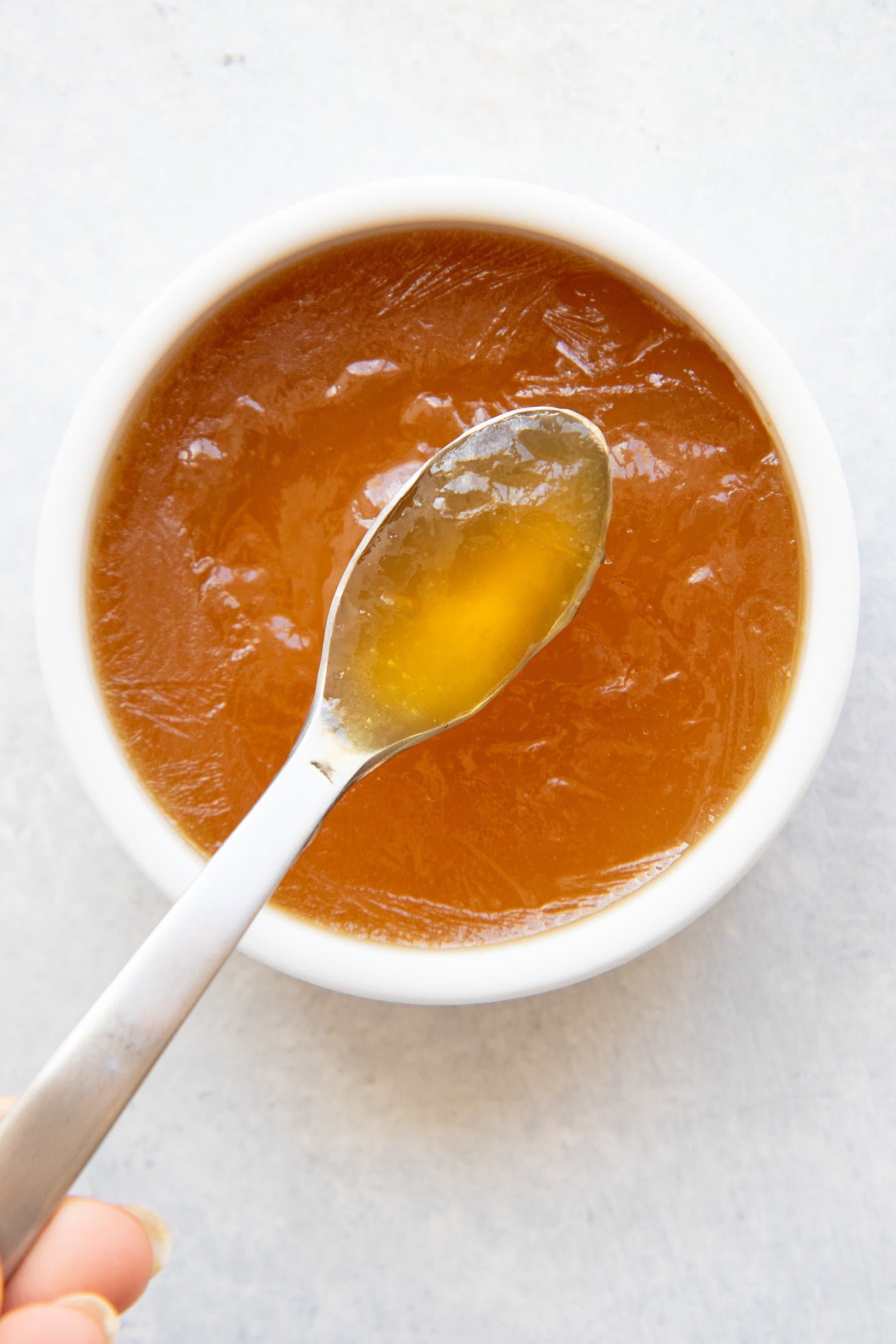
My main reason for drinking bone broth is to help with joint pain associated with Lyme disease. The bacteria that cause Lyme actually feeds on the collagen in joints (which is why severe joint pain is a common Lyme symptom). When I keep up with my daily broth habit, I feel noticeably less achiness and stiffness in my knees, hips, and rib cage. I have genetically weak knees, and I plan on keeping up with bone broth to help keep my knees as happy and healthy as long as possible! Enjoy!
This blog post is sponsored by Kettle & Fire Bone Broth.
This blog post is sponsored by Kettle & Fire Bone Broth. The content and opinions expressed here are my own.
Want to be a sponsor? Let's work together!
Source: https://wholefully.com/bone-broth/

0 Response to "Slow Cook Beef Bone Broth Instapot"
Post a Comment